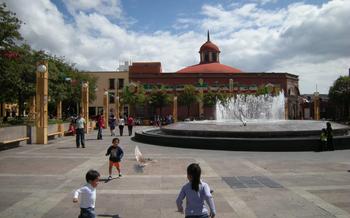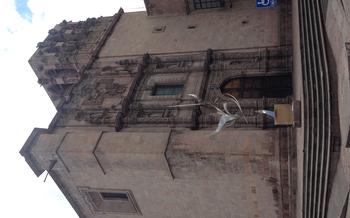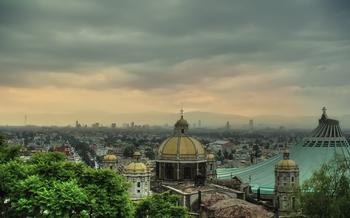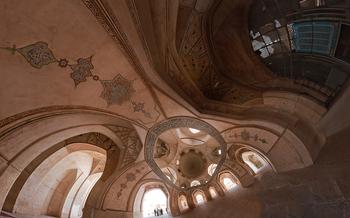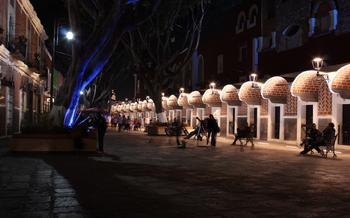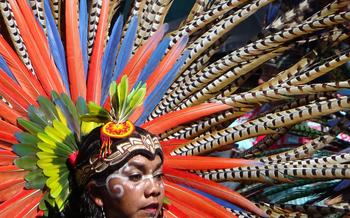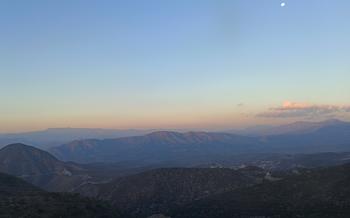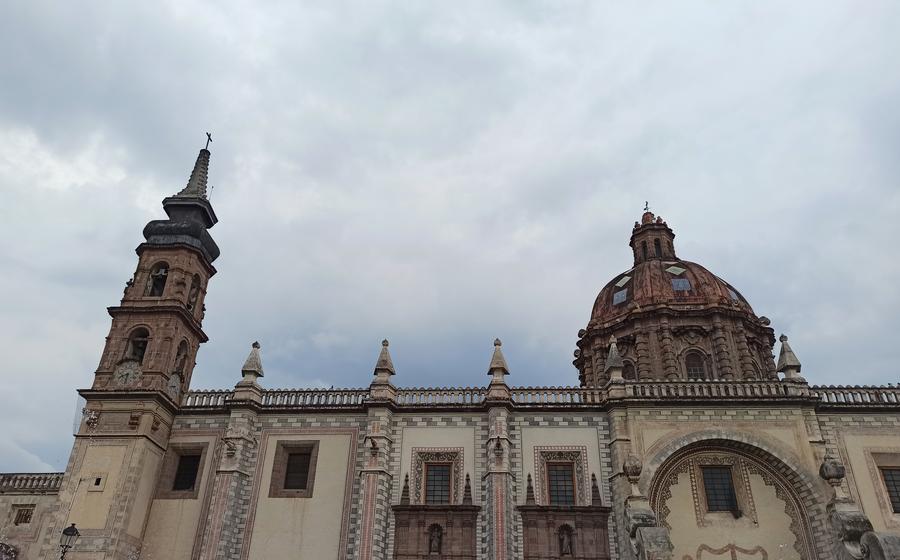
Santa Rosa de Viterbo Church
- Santa Rosa de Viterbo Church: A Historical and Architectural Gem
- Exploring the Church's Interior
- The Life of Santa Rosa de Viterbo:
- Pilgrimage and Religious Significance
- Adjoining Convent and Gardens
- Interactive Tours and Workshops
- Getting There and Accessibility
- Photography Tips and Etiquette:
- Plan Your Visit: Mass Timings and Events
- Dress Code and Cultural Sensitivity:
- Souvenirs and Religious Artifacts:
- Combining Your Visit with Other Attractions:
- Tips for a Memorable Experience:
Santa Rosa de Viterbo Church: A Historical and Architectural Gem
Viterbo Church, a testament to the city's rich history and architectural prowess. Built in the 18th century, this Baroque masterpiece commands attention with its imposing facade adorned with intricate carvings and sculptures that narrate the life of the church's patron saint, Santa Rosa de Viterbo. As a designated cultural heritage site, the church holds immense significance, not only as a religious monument but also as a symbol of Queretaro's cultural identity. Its unique fusion of architectural styles, including Baroque, Neoclassical, and Churrigueresque, makes it an architectural wonder that continues to captivate visitors from around the world.
Exploring the Church's Interior
The interior of the Santa Rosa de Viterbo Church is a testament to the artistic and spiritual devotion that went into its creation. As you step inside, you'll be greeted by a sense of awe and wonder. The layout of the church is designed to draw your gaze towards the main altar, which is adorned with intricate carvings and gilded embellishments.
Significant altars and sculptures are placed throughout the church, each telling a story or representing a different aspect of the Catholic faith. Take your time to admire the delicate details and craftsmanship of these religious artworks, which have been preserved and restored over the centuries.
Don't miss the stunning stained glass windows that adorn the church's walls. These colorful masterpieces depict biblical scenes and figures, casting a warm and ethereal glow into the interior space. Each window tells a story, inviting visitors to contemplate their symbolism and deeper meanings.
The Life of Santa Rosa de Viterbo:
Santa Rosa de Viter devotion and charitable works. Born in Viterbo, Italy, in 1233, she exhibited a deep spiritual connection from a young age. Renouncing worldly possessions, she embraced a life of poverty and service, devoting herself to the care of the sick and the needy.
Throughout her life, Santa Rosa's piety and charitable acts earned her a reputation for holiness. She possessed a profound love for the Eucharist and spent long hours in prayer and contemplation. Her unwavering devotion to God and her compassionate nature inspired many, drawing followers who sought guidance and spiritual direction.
In 1252, at the age of 19, Santa Rosa passed away, leaving behind a legacy of love and service. Her canonization in 1457 solidified her status as a saint, and her feast day is celebrated on September 4th. Pilgrims from around the world flock to Queretaro to pay homage to Santa Rosa and seek her intercession.
The church dedicated to her in Queretaro stands as a testament to her enduring legacy. Within its walls, visitors can learn about her life, admire the artistic depictions of her story, and draw inspiration from her unwavering faith and compassion.
Pilgrimage and Religious Significance
The Santa Rosa de Viterbo Church holds immense religious significance, attracting pilgrims from near and far. It is renowned as a sacred destination for those seeking spiritual fulfillment and divine blessings. Devotees flock to the church to pay homage to Santa Rosa de Viterbo, whose life and virtues inspire faith and devotion.
Pilgrimages to the church are particularly prominent during the annual feast day of Santa Rosa, celebrated on September During this time, the church transforms into a vibrant hub of religious fervor, adorned with colorful decorations and resounding with hymns and prayers. Pilgrims undertake long journeys to participate in the grand processions, seeking blessings and expressing their gratitude to the saint.
Religious ceremonies and festivals are an integral part of the church's calendar, drawing worshippers from across the region. These events provide an opportunity for the faithful to come together, celebrate their shared beliefs, and strengthen their connection to the divine. The church's profound religious significance continues to captivate hearts and minds, making it a cherished destination for pilgrims and believers.
Adjoining Convent and Gardens
The Santa Rosa de Viterbo Church is part of a larger complex that includes an adjoining convent and gardens. The convent, known as the Convento de Santa Rosa de Viterbo, was founded in 1700 and served as a residence for the nuns of the Order of Saint Augustine. The nuns played a vital role in the community, providing education and healthcare to the local population.
The convent features a beautiful courtyard surrounded by arched walkways and adorned with colorful tiles. Visitors can admire the intricate frescoes and paintings that decorate the walls of the convent, depicting scenes from the life of Santa Rosa de Viterbo and other religious figures.
The gardens of the convent offer a tranquil oasis amidst the bustling city. Visitors can stroll through the lush greenery, admire the vibrant flowers, and relax in the peaceful atmosphere. The gardens are a popular spot for contemplation and reflection, and they provide a picturesque backdrop for photos.
The convent and gardens are open to the public and are a must-visit for anyone interested in the history and culture of Queretaro. Visitors can learn about the life of Santa Rosa de Viterbo, explore the beautiful architecture of the convent, and enjoy the serenity of the gardens.
Interactive Tours and Workshops
To enhance your understanding and appreciation of the Santa Rosa de Viterbo Church, guided tours are available to delve into its history, architecture, and religious significance. Knowledgeable guides will lead you through the church's grand spaces, narrating tales of its past and highlighting its captivating features.
Beyond guided tours, the church offers a range of workshops that cater to diverse interests. Art enthusiasts can participate in painting or mural-making workshops, learning from skilled local artists and creating their own masterpieces inspired by the church's artistic legacy. History buffs can immerse themselves in interactive sessions exploring the church's rich past and its role in shaping the city's identity. There are also cultural workshops that delve into traditional Mexican crafts, music, or dance, providing visitors with hands-on experiences that connect them with the local culture.
Getting There and Accessibility
The Santa Rosa de Viterbo Church is situated in the heart of Queretaro, a city in central Mexico. It is easily accessible by public transportation, with several bus routes stopping nearby. The nearest bus stop is located just a few minutes' walk from the church, making it convenient for visitors to reach the site. For those traveling by car, there is limited street parking available in the surrounding area. However, it is recommended to arrive early to secure a parking spot, especially during peak tourist seasons. The church is wheelchair accessible, with ramps and elevators provided for visitors with disabilities. Additionally, guided tours in sign language are available upon request, ensuring that everyone has the opportunity to experience the beauty and history of this remarkable landmark.
Photography Tips and Etiquette:
When visiting the Santa Rosa de Viterbo Church, it's important to be mindful of photography etiquette to ensure a respectful and enjoyable experience for all. Here are some tips to keep in mind:
-
Respect the Privacy of Others: Avoid taking photos of people without their permission, especially during religious services or private moments.
-
Use Discreet Lighting: Flash photography is generally not allowed inside the church, as it can be disruptive and damaging to the artworks. Instead, use natural light or low-light settings on your camera to capture the beauty of the interior.
-
Capture the Essence: Focus on capturing the unique architectural features, murals, and stained glass windows that make the church special. Try to convey the spiritual and historical significance of the space through your photographs.
-
Observe the Signs: Be aware of any signs or guidelines posted within the church regarding photography. Some areas may have restrictions or require special permission for photography.
-
Maintain a Respectful Demeanor: Remember that the church is an active place of worship for many people. Be respectful of those engaged in prayer or contemplation, and avoid creating any disturbances while taking photos.
Plan Your Visit: Mass Timings and Events
Before embarking on your journey to the Santa Rosa de Viterbo Church, it's essential to plan your visit strategically to coincide with significant occasions that enhance the experience. The church hosts regular masses and religious services throughout the week, offering a chance for visitors to immerse themselves in the spiritual atmosphere. Additionally, special events and festivals are held throughout the year, attracting pilgrims and visitors from near and far.
To make the most of your visit, research and plan your trip accordingly. Check the church's official website or local tourism resources for an updated schedule of masses, events, and festivals. If you're particularly interested in witnessing a specific celebration, such as the feast day of Santa Rosa de Viterbo, plan your visit to coincide with these special occasions.
Attending a mass or religious service at the Santa Rosa de Viterbo Church is a deeply moving experience, allowing visitors to connect with the local community and witness the devotion and faith that permeate this sacred space. Whether you're a pilgrim seeking spiritual enlightenment or a traveler eager to explore the cultural heritage of Queretaro, planning your visit to align with special events and services will undoubtedly enrich your experience.
Dress Code and Cultural Sensitivity:
When visiting the Santa Rosa de Viterbo Church, it is important to dress appropriately to show respect for the religious significance of the site. While there is no strict dress code, modest attire is generally recommended. Avoid wearing shorts, tank tops, or revealing clothing. For women, it is customary to cover their shoulders and knees.
Beyond dress code, it is essential to be mindful of cultural sensitivities when visiting the church. Visitors should maintain a respectful demeanor, avoiding loud conversations or disruptive behavior. Photography is permitted, but it is important to be discreet and avoid taking photos of people without their consent.
By observing proper dress code and cultural etiquette, visitors can contribute to the preservation and appreciation of the Santa Rosa de Viterbo Church as a sacred space for both locals and pilgrims.
Souvenirs and Religious Artifacts:
As you wander through the church grounds, you'll find an assortment of shops and vendors offering a variety of souvenirs and religious artifacts. These items serve as tangible mementos of your visit and a way to support local artisans and craftspeople. From intricately carved wooden figurines to hand-painted ceramic tiles, you'll find a treasure trove of unique pieces that capture the essence of the church's history and artistry.
If you're seeking a deeper connection to the spiritual significance of the site, consider purchasing a religious artifact or memento. These items, such as rosaries, crucifixes, or small statues of saints, are not only beautiful but also hold deep meaning for many visitors. By purchasing these items, you're not only taking home a piece of the church's history but also contributing to the preservation and upkeep of this sacred space.
Combining Your Visit with Other Attractions:
Queretaro offers a wealth of other attractions that you can conveniently combine with your visit to the Santa Rosa de Viterbo Church. Embrace the city's colonial charm by exploring its historic center, a UNESCO World Heritage Site. Admire the baroque architecture of the Templo de San Francisco, marvel at the grandeur of the Teatro de la República, and wander through the picturesque plazas, such as Plaza de Armas and Plaza Fundadores.
Delve into the city's rich art and culture at the Museo Regional de Querétaro, showcasing pre-Columbian artifacts and colonial-era paintings. Visit the Museo de la Ciudad, housed in a former convent, to learn about Queretaro's history and traditions. Don't miss the opportunity to sample the city's delectable cuisine at local restaurants, savoring traditional dishes like enchiladas queretanas and gorditas de migajas.
Extend your exploration to the surrounding areas of Queretaro. Embark on a day trip to the Peña de Bernal, the third-largest monolith in the world, offering stunning views and opportunities for hiking and rock climbing. Discover the charming towns of Tequisquiapan and San Juan del Río, known for their vineyards, hot springs, and colonial architecture.
Plan a comprehensive itinerary that allows you to immerse yourself in Queretaro's diverse offerings. Allocate sufficient time to experience the city's vibrant culture, savor its culinary delights, and uncover its hidden gems. Whether you're a history buff, an art enthusiast, or a nature lover, Queretaro promises an unforgettable adventure.
Tips for a Memorable Experience:
To truly immerse yourself in the tranquility and beauty of Santa Rosa de Viterbo Church, consider visiting during the early morning or late afternoon when the crowds are fewer. This will allow you to fully appreciate the intricate details of the architecture and artwork without distractions. Additionally, avoid peak tourist seasons to enhance your experience further. By visiting during quieter times, you can take advantage of the peaceful ambiance and have more opportunities for quiet reflection and contemplation. Embrace the serenity of the church and let its spiritual essence envelop you.
